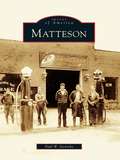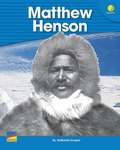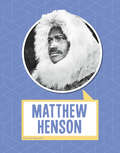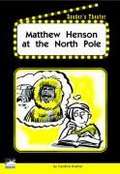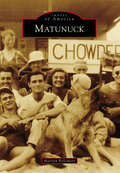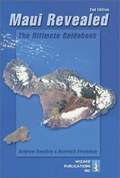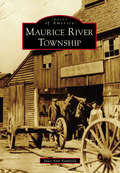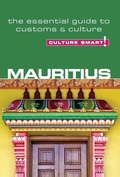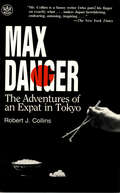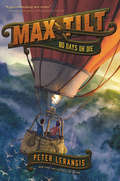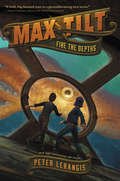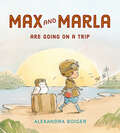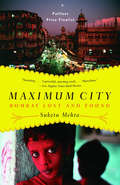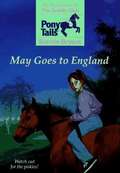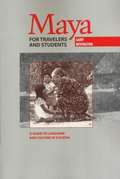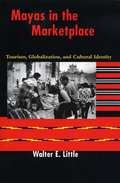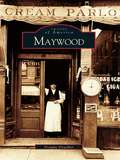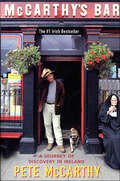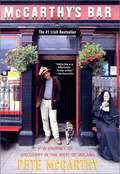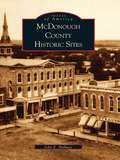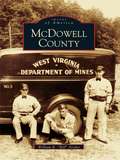- Table View
- List View
Matteson (Images of America)
by Paul W. JaenickeThe village of Matteson was founded in 1855 and named after the 10th governor of Illinois, Joel Matteson. German immigrants were the area's first settlers, seeking agriculture and business opportunities. The Illinois Central and Michigan Central Railroads provided the stimulus for the growth of one of the first communities to the south of Chicago. The area became popular in the 1890s, when Chicago residents rode special trains to visit the amusement park run by Moses and Freeman Elliott. By the mid-20th century, the town had established itself as a growing bedroom community due to the electrification of the Illinois Central suburban service in 1926 and an increase in residential housing designed for American GIs returning home after World War II. Transportation has always played a key role in the development of the village, which sits at the crossroads of America's first land grant railroad, the Illinois Central, and the country's first transcontinental road, the Lincoln Highway. Since the 1970s, Matteson has grown intoa vibrant retail and commercial area for Chicago's south suburbs.
Matthew Henson
by Maryann N. WeidtMathew Henson survived poverty and racism as an African American, and he survived the dangers and challenges of the Arctic one of the first people to reach the North Pole. This book tells the story of a man who risked his life to achieve his dreams.
Matthew Henson (Biographies)
by A.M. ReynoldsHow much do you know about Matthew Henson? Find out the facts you need to know about this explorer of the Arctic. You'll learn about the early life, challenges, and major accomplishments of this important American.
Matthew Henson at the North Pole
by Candice Kramer Pam Hirschfeld Karen LeonPerform this script about Robert Peary's discovery of the North Pole and how his assistant, Matthew Henson, played a major role in the expedition.
Matunuck
by Marilyn BellemoreThe village of Matunuck lies on the south coast of Rhode Island in the town of South Kingstown. It was first inhabited by Native Americans, followed by the early Pettaquamscutt settlers, but it was not until after the end of the Civil War that it became a destination for leisure and fun. This took the form of tent colonies on the beach and local farmers that rented out rooms and cottages to summer guests. Today, surfing, fishing, and sunbathing are popular activities at the beloved beaches, yet there is more that draws the thousands of tourists who visit each year. Theatre By The Sea has hosted world-renowned actors like Marlon Brando and Mae West, and beachfront establishments have long attracted a variety of musical acts. The village is also home to a national wildlife refuge, Trustom Pond, that is a safe haven to an array of species and is still preserved today.
Maui Revealed: The Ultimate Guidebook (2nd edition)
by Harriett Friedman Andrew Doughty"A complete traveler's reference to the Hawaiian island of Maui with full color illustrations, maps, directions, and candid advice by authors who reside in Hawaii." Other books about Hawaii are available from Bookshare.
Maui: A Day-by-Day Plan for Your Dream Vacation
by Andrea Lown Rose Gully Geoff MoysaA day-by-day plan for an unforgettable, stress-free vacation in Maui. Rose + Gully has done all the research to create the ultimate holiday with just the right amount of rest and relaxation combined with off the beaten path adventure. This tested, 9-day itinerary takes you through the island's best beaches, snorkeling spots, hidden waterfalls, shopping and more. What's in the guide?The Itinerary:* 9 full-day itineraries with daily activities and meals to help you make the most out of your trip* Local tips and recommendations to get you off the beaten path* West Maui's most spectacular beaches and secluded snorkeling spots, exhaustively tested by Rose + Gully's dedicated team* Detailed day trips for the Road to Hana drive, Haleakala Crater and Upcountry* Additional restaurants, activities and options to customize the itinerary to your unique tastes and budget Accommodations, Car Rentals & Other Logistics:* Recommended accommodations close to the action ranging from posh resorts to cool vacation rentals* Options and advice for Maui car rentals* Handy collection of booking tips, tricks and links plus exclusive Maui deals* Simple, delicious recipes and grocery list using fresh local ingredients for condo rentals with kitchens* Packing checklist designed specifically for Maui weather and activities* Stress-free route to take care of all holiday logistics such as groceries, snorkeling gear, car rentals and more
Maurice River Township (Images of America)
by Julie Ann RumboldThe Maurice River Township area was first settled by the Lenni-Lenape along the Maurice River prior to the arrival of European explorers in the 1600s. The Maurice River became important for many industries, including oystering, commercial fishing, and crabbing. Dorchester and Leesburg, especially the Delaware Bay Shipbuilding Company, were well known for shipbuilding, and the area was very active during World War II. The township has been long recognized for agriculture due to its wonderful sandy ground. The soil has played an important role in the glass industry since the late 1800s, with the silica/sand utilized in a thriving glass-manufacturing business, initially in Port Elizabeth. The railroads were first built to ship oysters to large cities in the late 1800s to mid-1900s but were also employed to transport sand for the glass business and wood for the lumber industry. Many of the enterprises from earlier days have vanished in time, and along with them, some villages have entirely disappeared.
Mauritius - Culture Smart!
by Tim ClearyMauritius is a conundrum. A small, exotic, multiethnic island nation in the Indian Ocean, to some it is a multicultural "rainbow," a haven of peace, love, and understanding. Others see it as ethnically divided, cultivating only "sugarcane and prejudice." Opinions differ as to whether it is a Creole island, a Hindu-dominated Little India, or a neo-colonial outpost of the French-speaking world. Optimists see it as the biggest social and economic miracle of the post-colonial world, whereas pessimists believe it to be a social accident waiting to happen. For many visitors Mauritius appears to be a carefree tropical paradise, but its complexity will baffle any foreigner who dares to leave the comfort of the luxury beach resort. Daily life is far from idyllic for the majority of the population struggling to reconcile traditional culture and old ethno-religious antagonisms with the demands of the modern world. Mauritius is a very new nation, formed over the past three centuries. Although the South and East Asian influence is very strong, its most defining characteristic is its very multiculturalism. Its traditions reflect the diversity of the people, and Mauritian language, food and religion form an intoxicating medley. Other customs have been created locally and are shared by all, such as the lively and popular musical tradition of sega. Modernization and global economics mean many younger Mauritians now share a common culture and outlook on life, where the sense of being Mauritian outweighs ancestral ties and divisive communalism. Culture Smart! Mauritius will help you make sense of the modern and the traditional, of shared and ancestral culture, and enable you to navigate your way through the contradictions at the heart of modern Mauritius. Show the expected courtesy and respect and you will meet many extraordinary, warm-hearted, patient, and friendly people who are keen to welcome outsiders from any part of the world.
Max Danger
by Robert J. CollinsFollow the adventures of Tokyo's favorite expatriate Max Danger, as he weaves his way in and out of the intricacies and dilemmas of living in Japan from baffling bilingual breakfast meetings, through the mind-boggling enigmas of doing business in Japan, to the dubious pleasures of late-night hostess clubs. Max Danger seems to exhaust himself just trying to make it through the day.
Max Tilt: 80 Days Or Die (Max Tilt #2)
by Peter LerangisThe New York Times bestselling author of the Seven Wonders series and of books in the 39 Clues series, Peter Lerangis, brings us the hair-raising, edge-of-your-seat second installment of the Max Tilt trilogy. <P><P>When thirteen-year-old Max Tilt stumbled across his great-great-great-grandfather Jules Verne’s unfinished, unpublished manuscript, The Lost Treasures, he thought he had the answer to all his problems, but nothing in life is ever that easy. With his mom’s illness getting worse again, Max needs to figure out a way to save his family—now more than ever. <P><P>So Max and his cousin Alex revisit The Lost Treasures, and they find a clue that just might be the key to a cure. It’s the story of Verne’s seemingly impossible recovery from a near-fatal gunshot wound. Somehow, after being shot, Verne didn’t just survive, he thrived. <P><P>And the book hints that he was only able to do so after collecting magical healing elements that he’d saved from a race around the world. <P><P>Piecing together hints from Verne’s Around the World in 80 Days and his lost manuscript, Max and Alex realize there’s a way to save Max’s mom if they’re daring enough to try. It’s a race against time in the second installment of the action-packed adventure series from master storyteller and New York Times bestselling author Peter Lerangis.
Max Tilt: Fire the Depths (Max Tilt #1)
by Peter Lerangis“A bold, big-hearted start to a groundbreaking new series.” —Soman Chainani, author of The School for Good and EvilThe New York Times bestselling author of the Seven Wonders series and books in the 39 Clues series, Peter Lerangis, brings us the enthralling first installment of the adventure-filled Max Tilt trilogy. When thirteen-year-old Max Tilt happens upon his great-great-great-grandfather Jules Verne’s unfinished, unpublished manuscript, The Lost Treasures, he doesn’t realize that he’s found the answers to all his problems. And Max has a lot of problems—his mother is sick, his father is out of work, and his home is about to be foreclosed on. But when Max and his cousin Alex discover that Verne’s last work reveals everything he wrote was fact, not fiction, they realize that the book holds the key to something incredibly valuable. A treasure that can save his house—and maybe his entire family.But Max and Alex aren’t the only ones who know about Verne’s clues. Spencer Niemend, a strange skunk-haired man who has spent his life researching Verne’s works, is bent on reshaping the world with the hidden treasure. To find it first, Max and Alex must go on an adventure that’ll take them from the broken remains of an underwater city to the very jaws of a giant squid to the edges of a whirlpool from which no one has ever emerged alive. This is the first book in a new hair-raising, edge-of-your-seat adventure series from master storyteller and New York Times bestselling author Peter Lerangis.
Max and Marla Are Going on a Trip
by Alexandra BoigerFrom the #1 New York Times bestselling illustrator of She Persisted comes a Max and Marla story about being present and appreciating the world around us.School is out for the summer, and Max and Marla are off to Australia! Max has always wanted to see koalas, after all. He makes sure to pack his camera for the trip, so that he can capture every moment and remember this vacation. Off they head by air and by sea, with Max looking for just the perfect shot along the way. But when he keeps missing the amazing sights while focusing his lens, Marla knows that she needs to step in.In this final story in the Max and Marla quartet, the two friends learn that being together and enjoying their trip makes for the best memories after all!Praise for Max and Marla Are Going on a Trip:"A delightful lesson in the joy of living in the moment." --Kirkus"Tender and humorous . . . The underlying message to adjust some of our screen-centric habits in order to appreciate the natural world with open eyes and reverence is a plain truth with value for readers of all ages." --SLJ
Maximum City
by Suketu MehtaA native of Bombay, Suketu Mehta gives us an insider's view of this stunning metropolis. He approaches the city from unexpected angles, taking us into the criminal underworld of rival Muslim and Hindu gangs; following the life of a bar dancer raised amid poverty and abuse; opening the door into the inner sanctums of Bollywood; and delving into the stories of the countless villagers who come in search of a better life and end up living on the sidewalks.From the Trade Paperback edition.
Maximum City: Bombay Lost and Found
by Suketu MehtaA brilliantly illuminating portrait of Bombay and its people--a book as vast, diverse, and rich in experience, incident, and sensation as the city itself--from an award-winning Indian-American fiction writer and journalist. A native of Bombay, Suketu Mehta gives us a true insider's view of this stunning city, bringing to his account a rare level of insight, detail, and intimacy. He approaches the city from unexpected angles-taking us into the criminal underworld of rival Muslim and Hindu gangs who wrest control of the city's byzantine political and commercial systems ... following the life of a bar dancer who chose the only life available to her after a childhood of poverty and abuse ... opening the doors onto the fantastic, hierarchical inner sanctums of Bollywood ... delving into the stories of the countless people who come from the villages in search of a better life and end up living on the sidewalks--the essential saga of a great city endlessly played out. Through it all--as each individual story unfolds--we hear Mehta's own story: of the mixture of love, frustration, fascination, and intense identification he feels for and with Bombay, as he tries to find home again after twenty-one years abroad. And he makes clear that Bombay--the world's largest city--is a harbinger of the vast megalopolises that will redefine the very idea of "the city" in the near future. Candid, impassioned, funny, and heartrending, Maximum City is a revelation of an ancient and ever-changing world.
May Goes to England (Pony Tails #11)
by Bonnie BryantMay and her family are spending two spring weeks in England. Her sisters, Dottie and Ellie, continuously tease May about piskies -- spirits who hide in the cracks of Cornwall and come out to make mischief. The region also has ponies which May has never seen. When the girls venture out one night, Ellie falls, twists her ankle and can't walk. May must ride a strange pony through pisky territory to get help!
Maya for Travelers and Students: A Guide to Language and Culture in Yucatan
by Gary BevingtonThe Yucatan Peninsula draws many North American and European travelers each year to view the ruins of the pre-Columbian Classical Maya civilization and the abundant native flora and fauna. For these travelers, as well as armchair travelers and students, Gary Bevington has prepared the first general English-language introduction to Yucatec Maya, the native language of the people indigenous to the region. Written in nontechnical terms for learners who have a basic knowledge of simple Mexican Spanish, the book presents easily understood, practical information for anyone who would like to communicate with the Maya in their native language. In addition to covering the pronunciation and grammar of Maya, Bevington includes invaluable tips on learning indigenous languages "in the field. " Most helpful are his discussions of the cultural and material worlds of the Maya, accompanied by essential words and expressions for common objects and experiences. A Maya-English-Spanish glossary with extensive usage examples and an English-Maya glossary conclude the book. Note: The supplemental audiocasette, Spoken Maya for Travelers and Students, is now available as a free download.
Mayas in the Marketplace: Tourism, Globalization, and Cultural Identity
by Walter E. LittleSelling handicrafts to tourists has brought the Maya peoples of Guatemala into the world market. Vendors from rural communities now offer their wares to more than 500,000 international tourists annually in the marketplaces of larger cities such as Antigua, Guatemala City, Panajachel, and Chichicastenango. Like businesspeople anywhere, Maya artisans analyze the desires and needs of their customers and shape their products to meet the demands of the market. But how has adapting to the global marketplace reciprocally shaped the identity and cultural practices of the Maya peoples? Drawing on over a decade of fieldwork, Walter Little presents the first ethnographic study of Maya handicraft vendors in the international marketplace. Focusing on Kaqchikel Mayas who commute to Antigua to sell their goods, he explores three significant issues: sum; how the tourist marketplace conflates global and local distinctions. sum; how the marketplace becomes a border zone where national and international, developed and underdeveloped, and indigenous and non-indigenous come together. sum; how marketing to tourists changes social roles, gender relationships, and ethnic identity in the vendors' home communities. Little's wide-ranging research challenges our current understanding of tourism's negative impact on indigenous communities. He demonstrates that the Maya are maintaining a specific, community-based sense of Maya identity, even as they commodify their culture for tourist consumption in the world market.
Maybe One Day: Escape with the most uplifting, romantic and heartwarming must-read book of the year!
by Debbie Johnson'A laugh-cry book from first page to last' MILLY JOHNSON'Simply brilliant' JANE LINFOOT'A proper heart-burster' LAURA KEMP'Moving, beautiful and heart-wrenching' CATHY BRAMLEY'Humour, tears and above all, hope. Bring tissues' CATHERINE ISAACWhat if you had the chance to find a lost love? Jess still thinks about the man who disappeared from her life seventeen years ago, and the tragedy that tore them apart. So when she discovers a hidden box of letters in her mother's attic, Jess realises that the truth about why he walked away has been kept from her all this time. Jess sets out to follow the faded postmarks across the country, determined that her journey will bring her closer to him. As each clue falls into place, Jess discovers new things about herself - and the man who once broke her heart. Maybe she can find him. Maybe their love story isn't over.Maybe one day, they will be together again...Readers are loving Maybe One Day:'Wow! Wow! Wow!' Reader Review'One of the best Debbie Johnson books I have ever read' Reader Review'Just fabulous' Reader Review'Funny, emotional, heartbreaking and beautifully uplifting' Reader Review'Love, love, loved it' Reader Review
Maywood (Images of America)
by Douglas DeuchlerTen miles west of Chicago on the west bank of the Des Plaines River sits Maywood, a village that was founded in 1869 by seven New England businessmen who established the Maywood Land Company. This prairie community, carefully laid out along the railroad, experienced a population boom after the Great Chicago Fire of 1871. Soon industry arrived, followed by a variety of ethnic groups. Maywood was one of the few early suburban communities with an African-American neighborhood.
McCarthy's Bar: A Journey of Discovery in Ireland
by Pete McCarthy"It was half past five in the morning as I lurched through the front door of the B&B. Mrs. O'Sullivan appeared just in time to see me pause to admire the luminous Virgin holy water stand with integral night-light, and knock it off the wall. Politely declining the six rounds of ham sandwiches on the tray she was holding, I edged gingerly along the hallway to the wrong bedroom door and opened it."Despite the many exotic places Peter McCarthy has visited, he finds that nowhere else can match the particular magic of Ireland, his mother's homeland. In McCarthy's Bar, his journey begins in Cork and continues along the west coast to Donegal in the north. Traveling through spectacular landscapes, but at all times obeying the rule, "never pass a bar that has your name on it," he encounters McCarthy's bars up and down the land, meeting fascinating people before pleading to be let out at four o'clock in the morning.Through adventures with English hippies who have colonized a desolate mountain; roots-seeking, buffet-devouring American tourists; priests for whom the word "father" has a loaded meaning; enthusiastic Germans who "here since many years holidays are making;" and his fellow barefoot pilgrims on an island called Purgatory, Peter pursues the secrets of Ireland's global popularity and his own confused Irish-Anglo identity.Written by someone who is at once an insider and an outsider, McCarthy's Bar is a wonderfully funny and affectionate portrait of a rapidly changing country.
McCarthy's Bar: A Journey of Discovery in the West Of Ireland
by Pete Mccarthy"It was half past five in the mornin' as I lurched through the front door of the B&B. Mrs. O'Sullivan appeared just in time to see me pause to admire the luminous Virgin holy water stand with integral night-light, and knock it off the wall. Politely declining the six rounds of ham sandwiches on the tray she was holding, I edged gingerly along the hallway to the wrong bedroom door and opened it." Despite the many exotic places Pete McCarthy has visited, he finds that nowhere else can match the particular magic of Ireland, his mother's homeland. In McCarthy's Bar, his journey begins in Cork and continues along the west coast to Donegal in the north. Traveling through spectacular landscapes, but at all times obeying the rule,"never pass a bar that has your name on it," he encounters McCarthy's bars up and down the land, meeting fascinating people before pleading to be let out at four o'clock in the morning. Through adventures with English hippies who have colonized a desolate mountain; roots-seeking, buffet-devouring American tourists; priests for whom the word "father" has a loaded meaning; enthusiastic Germans who "here since many years holidays are making;" and his fellow barefoot pilgrims on an island called Purgatory, Pete pursues the secrets of Ireland's global popularity and his own confused Irish-Anglo identity. Written by someone who is at once an insider and an outsider, McCarthy's Bar is a wonderfully funny and affectionate portrait of a rapidly changing country.
McDonough County Historic Sites
by John E. HallwasMcDonough County Historic Sites depicts a remarkable agricultural region steeped in 19th-century tradition and community spirit. Originally set aside by Congress for veterans of the War of 1812 as part of the Illinois Military Tract, the land that is now McDonough County was settled by a diverse and ambitious population starting in the 1820s. From the trials of settlement to the coming of railroads and the establishment of small-town culture, McDonough County history reflects developments that have shaped America. The region's cemeteries, businesses, and homes that have endured-or vanished-offer stories of human endeavor that unite the people of the county to this day. The maps accompanying the chapters locate the county's many historic sites, such as the hotel in Macomb where Lincoln stayed during his 1858 campaign, the Prairie City Drugstore that launched a national poetry publishing company, and the remote village of Vishnu Springs that is now a ghost town. The historic images illustrate McDonough County's progress and controversy, small-town life and rural development, as well as religious diversity and cultural achievement.
McDowell County
by William R. ArcherMcDowell County was established by an act of the Virginia General Assembly in 1858, two years before the start of the American Civil War. In 1863, the county was one of the 55 that separated from the Old Dominion to form West Virginia, thus earning the nickname "the Free State." Long before this, though, McDowell County was known for its bountiful natural resources; a great geologist, Dr. Thomas Walker, touted these vast "coal lands" after his 1748-1750 exploration. Political leaders like Thomas Jefferson, who knew of the county's mineral wealth, steered Robert Morris, financier of the American Revolution, to obtain all of McDowell County in the land speculation boom of the mid-1790s. After Morris was sent to debtor's prison in 1799, however, his land holdings were acquired by Michael Bouvier, a cabinet maker. In the 1920s, the remains of Bouvier's holdings were purchased by Henry Ford, the automobile tycoon. Other famous personalities associated with McDowell County include J.P. Morgan and Thomas "Stonewall" Jackson.
